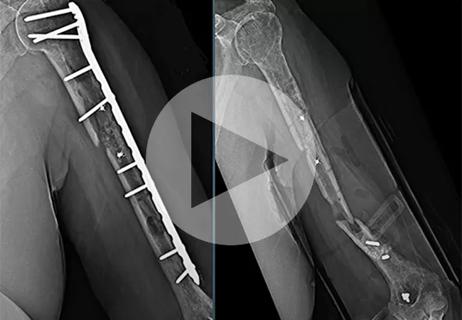Trauma patients present with infected pilon and distal femur fractures

By Ronald Peirish, DO; Damien Billow, MD; Cesar Cereijo, DO; and Anokha Padubidri, MD
Advertisement
Cleveland Clinic is a non-profit academic medical center. Advertising on our site helps support our mission. We do not endorse non-Cleveland Clinic products or services. Policy
When treating patients with a nonunion, the clinical question is whether it is best to perform a primary amputation or arthroplasty, or to proceed with limb salvage. Limb salvage can involve treatment in a single- or two-stage procedure. Treatment is personalized, based on the patient’s unique injury characteristics and shared decision-making between the surgeon and patient.
Here we present three cases in which the decision was made to proceed with limb salvage.
A 35-year-old female presented to our emergency department for severe left ankle pain after sustaining a left closed pilon fracture four weeks earlier. She initially had been treated at an outside hospital with external fixation followed by open reduction and internal fixation (ORIF) four days later. Her postoperative course was complicated by wound dehiscence with positive cultures for Enterobacter, which was treated with vacuum-assisted closure (wound vac) and intravenous antibiotics.
Radiographs of her ankle demonstrated malreduction and fracture gapping of the articular surface (Figure 1). Physical exam revealed a 4.5 cm anterior pretibial wound with serosanguinous drainage and exposed anterior tibial tendon and hardware (Figure 2). Additionally, the patient had a stage 1/2 pressure wound to her heel.
Reconstruction commenced with irrigation and debridement, removal of hardware, and application of a uniplanar external fixator with wound vac. She underwent serial debridements. She then had a repeat ORIF (Figure 3) and synthetic bone graft with gentamycin once the wound bed was clean, followed by an anterolateral thigh (ALT) free flap by plastic surgery to cover the pretibial wound.
Advertisement
Postoperatively, her fracture and free flap healed with no concern for continued infection.



A 70-year-old female with a medical history of smoking, deep vein thrombosis, chronic obstructive pulmonary disease, stage 3 chronic kidney disease and rheumatoid arthritis presented to our clinic for evaluation of continued pain and ambulatory dysfunction of her left lower extremity. After a left distal femur fracture, she had been treated at an outside hospital with a distal femoral locking plate. Her postoperative course was complicated by nonunion with hardware failure (Figure 4). She was treated with a bone stimulator and knee brace.
In our office, the patient stated that she could ambulate short distances with a walker but mostly used a wheelchair. On exam, her surgical incisions were well healed. The range of motion of her knee was 0-90 degrees of flexion with gross motion at the fracture site. Surgical intervention was recommended as the fracture was unlikely to heal due to instability at the fracture site.
The patient was taken to the operating room, where the previous hardware was removed, the nonunion site was debrided, the fracture was reduced, and a retrograde femoral nail was placed. Bone graft was applied to the fracture site from the left femur using a reamer-irrigator-aspirator (RIA) system.
Postoperatively, the fracture healed with maintained alignment (Figure 5). At her last clinic appointment, the patient was pain-free and ambulating with a walker.


A 32-year-old female presented to our office with a history of polytrauma. She had been hit by a motor vehicle and had sustained a right open distal femur fracture (grade 3A), right patella fracture, left closed midshaft femur fracture and bilateral distal radius fractures. Her right femur was treated at an outside hospital with a retrograde femoral nail and a two-stage Masquelet procedure to address a large bone void.
Advertisement
The patient presented to our office for continued right distal thigh pain, ambulatory dysfunction and a limb length discrepancy of 3 cm (Figure 6). Radiographs demonstrated an 8 cm bone void with nonunion (Figure 7).
Preoperative surgical planning commenced, and it was decided that a custom synthetic graft cage would be created to add 2 cm of length to her right lower extremity.
The patient was taken to the operating room, where the previous retrograde nail was removed, an osteotomy was created, and the femur was lengthened acutely using a femoral distractor. Bone graft was harvested from the femur and ipsilateral tibia by RIA. A new retrograde nail with a side plate was implanted into the femur. The bone graft was mixed with synthetic bone graft and impacted into the custom cage, which was inserted into the femur and secured with screws.
Postoperatively, the patient had two distal interlocking screws that loosened and became prominent. As a result, she had a subsequent surgery to remove the prominent screws. The patient progressed to full weight-bearing, and her last radiographs demonstrated maintained alignment with incorporation of the bone graft with bone bridging (Figure 8).



These three cases demonstrate that nonunions can cause severe dysfunction and pain.
Limb salvage is a viable option for certain patients, helping them return to function by preserving their native extremity.
Drs. Billow, Cereijo and Padubidri are orthopaedic traumatologists at Cleveland Clinic. Dr. Peirish is a trainee in Cleveland Clinic’s orthopaedic residency program.
Advertisement
Advertisement

Relieves discomfort, reduces opioid dependency and improves quality of life

Finally, a solution after multiple revision surgeries for delayed bone healing, loose hardware and unrelenting infection

Why shifting away from delayed repairs in high-risk athletes could prevent long-term instability and improve outcomes

Multidisciplinary care can make arthroplasty a safe option even for patients with low ejection fraction

Percutaneous stabilization can increase mobility without disrupting cancer treatment

Study shows that postop function is closer to normal than with total hip arthroplasty

A tailored approach combining injections, therapy and preventive care is improving outcomes for patients with elbow OA

Exploring new tools and techniques to improve the diagnosis and treatment of concussions.